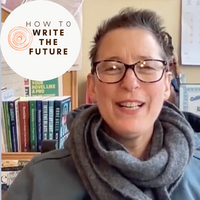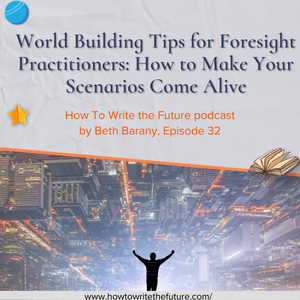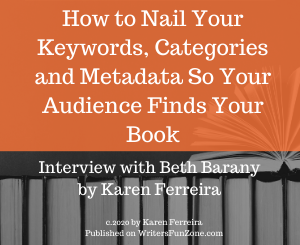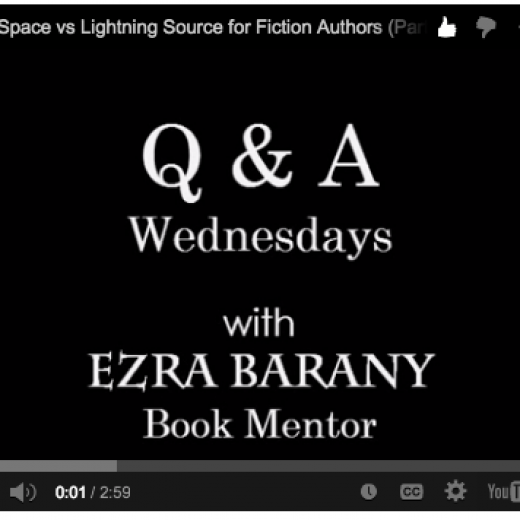World Building Tips for Foresight Practitioners: How to Make Your Scenarios Come Alive
In this How To Write the Future podcast episode, titled “World Building Tips for Foresight Practitioners: How to Make Your Scenarios Come Alive,” Beth Barany shares the six-step process that she uses when collaborating with foresight professionals and futurists and uses the acronym STEEP plus V to share examples of a possible positive scenario.
Platforms the podcast is available on Amazon Music | Buzzsprout | Apple Podcasts | Google Podcasts | Spotify | Podcast Addict |Youtube
RESOURCES
Association of Professional Futurists
Compass Magazine, Feb. 2023 issue
Get your free World Building Workbook for Fiction Writers:
https://writersfunzone.com/blog/world-building-resources/
SHOW NOTES
“All good stories are about people who want something so badly, they’re willing to face seemingly unsurmountable challenges to reach their goal.”
In this episode, “World Building for Foresight Practitioners: How To Make Your Scenarios Come Alive,” host Beth Barany, creativity coach, and science fiction and fantasy novelist, shares the six-step process that she uses when collaborating with foresight professionals and futurists, including how to create compelling scenarios to captivate their audiences and uses the acronym STEEP plus V to share examples of a possible positive scenario.
ABOUT THE HOW TO WRITE THE FUTURE PODCAST
The How To Write The Future podcast is for science fiction and fantasy writers who want to write positive futures and successfully bring those stories out into the marketplace. Hosted by Beth Barany, science fiction novelist and creativity coach for writers.
Tips for fiction writers!
This podcast is for you if you have questions like:
- How do I create a believable world for my science fiction story?
- How do figure what’s not working if my story feels flat?
- How do I make my story more interesting and alive?
This podcast is for readers too if you’re at all curious about the future of humanity.
TRANSCRIPT for Episode 32 World Building Tips for Foresight Practitioners: How to Make Your Scenarios Come Alive
World-building tips for foresight practitioners, how to make your scenarios come alive.
As a foresight practitioner, your job is to think about and analyze possible futures. One effective way to do this is through scenario building, which involves creating detailed stories about different possible futures. But how can we make our scenarios come alive to engage our audience and inspire them to take action toward a desired future?
In my foresight studies and in conversations with professional futurists and foresight practitioners, what I have found missing in these scenarios is often the human actor.
All good stories are about people who want something so badly, they’re willing to face seemingly unsurmountable challenges to reach their goal.
I subscribe to the view, that stories have been our way of testing out new, possible, probable, and even unlikely worst case scenarios for as long as we’ve been telling stories.
A compelling story comes down to the main character. We need to feel connected to them and can do that when we see ourselves in them through their hopes. And their dreams. Fears and worries. And especially by what they want, that is their goal and their motivation for that goal. We also need to see their humanity, vulnerability, heroic qualities, the way they care, and what’s at stake for them.
For example, if you’re writing scenarios about the future of the healthcare industry in the U S in 2050. You’ll want to create compelling stories to help interested parties make policy decisions and take specific actions toward an ideal future and avoid worst case futures.
So, how do we make something like the future of healthcare come alive?
As a science fiction and fantasy novelist and writing teacher and coach, I help foresight practitioners create compelling scenarios to captivate their audiences.
Here is a six step process I typically use when I collaborate with foresight professionals and futurists.
Step One – Define the setting of your Scenario
Since you’re writing scenarios about possible futures, defining the setting is an exercise in the imagination, based on signals from the edge, trends, and whichever drivers of change you want to emphasize.
Such drivers of change can include but aren’t exclusive to those listed here. I’ve used the acronym STEEP plus V which stands for:
S for Social. T for Technological. E for Economical. E for Environmental. P for Political. V for Values.
So create a rich, detailed vivid world by using specific nouns, powerful verbs, and emotionally charged adjectives. Using your imagination and what you know, you will most likely be making choices, filtered through a conscious and unconscious beliefs.
For illustrative purposes only based in my imagination here is how I use STEEP plus V to begin building out possible positive scenarios for the U.S. healthcare industry in the year 2050.
S for Social
Preventative healthcare is the norm. Fully supported by the population. And taught in schools from day one.
T for Technological
Home-health scanning apps are the norm and can monitor people in their homes noninvasively. People can have their data sent to their primary healthcare providers automatically. Tech like bacteria sensing toilets, temperature sensing sheets and pillows, and mood sensing, lighting exist. Self-driving cars and affordable high-speed trains make it easy to get to healthcare facilities. Medically trained androids serve as nurses. Customized gene therapy allows parents to treat babies with down syndrome in utero.
E for Economical
As healthcare is considered a right. And the healthcare system has become a nonprofit. All costs are spread across the entire population. Everyone benefits equally from excellent healthcare. Physicians and other healthcare providers are paid by the collective and have good standards of living.
E for Environmental
All hospitals and healthcare facilities have become energy self-sufficient along with all buildings. All medical waste is safely stored and eaten by bacteria where feasible.
P for Political
Peer councils work at the local level to speak for the needs of a locality as needs vary from place to place. This ensures that healthcare is a bottom up locally designed affair and the unique needs of different communities are made known. People goods and services are in the right place at the right time. An national body meets regularly made up of local representatives that rotate in annually from all eligible adults.
V for Values
Healthcare is considered a human right as all life is precious and no one person’s life is more valuable than any others as no one has more of anything. All people benefit from the bounty of the planet.
Step Two – Develop Your Characters
Choose at least one or two main characters to represent the different stakeholders in your scenario. For each of your characters, ground them in the setting details you chose in step one.
For example, using the details from Step one.
Clara: She’s a 25 year old single parent, pregnant with her first child, and wants a healthy baby and a seamless delivery. She’s highly introverted with few friends and family around her. She wants to avoid pain. She feels inadequate to the task of motherhood, despite lots of education and support from her community. Her goal is to find a doctor, doula, or midwife she likes and feels comfortable with to deliver her baby in seven months.
And Nelson: He’s a 45 year old house builder by trade. This year, he is the community health representative for Clara’s locality. His goal is to make sure everyone gets what they need from the healthcare providers. He’s concerned that he doesn’t know all there is to know to help everyone.
As part of developing the identity of your characters, don’t forget to set them in a specific location.
— Are they living in a big city or small town?
— Do they live in a location that is threatened by an outside threat” hurricanes wildfires, extreme drought, coastal flooding?
Consider the culture of the location.
Red, blue, or purple politics?
— Traditional or modern?
— A place of isolation or a place where everyone is moving to escape climate change?
— What do people do there for fun?
Step Three – Create a dilemma, conflict, or problem to overcome.
What challenges do your characters face and how do they overcome them?
Again, use your imagination. It’s the year 2050.
Are your characters facing the same challenges they face today? Or are there different challenges 30 years from now?
Incorporate conflict and tension into your story. This will make your scenario more engaging and help keep readers interested.
For example: what if Clara goes to meet a birth healthcare provider to choose them for her birthing and doesn’t get along with the people who are available?
That would be her dilemma and caused her all sorts of emotional distress.
What if in turn Nelson is handed this problem and at first feels inadequate to the task and finding Clara a suitable birth healthcare provider?
He speaks to every one available and sends them to Clara for interview. But Clara still says she doesn’t like them. So now it’s on Nelson to sort out this dilemma. How will he make sure Clara has the best possible care, even in the choosing process?
Ask
Ask yourself: what if
Other possible problems that our characters may face in 2050
Ask yourself: what if.
What if they found a good birth healthcare provider, but that person must travel far to arrive? So what if they may not arrive at time for the birthing? What if they find a backup person?
–What if Clara decides to travel where her birthing professional is, and as a shy person, needs to face the kindness of strangers? What if Nelson is the only one to travel with her and he hates trains?
–What if there’s another massive pandemic that is straining the U.S. healthcare system?
–What if all the Android nurses in the U.S. Hospital system are hit by a computer virus?
–What if Clara’s baby is diagnosed in the womb with a condition such as down syndrome or multiple sclerosis?
Step Four – Use sensory details to bring your world to life
This could include descriptions of sights sounds, smells, and other sensory experiences from your characters perspectives that helps your reader feel like they’re immersed in your scenario.
For example: Clara loves food and being pregnant heightens her sense of smell and taste leading to intense reactions in her environment and towards people. One of the reasons she rejects the healthcare professionals she meets is their smell. She can also be touch sensitive and only tolerate being physically close to those she knows. She might also only tolerate certain fabrics on her body.
For Nelson, he’s a tactile person and finds he can trust someone with a handshake. He had a hand in designing and building the healthcare facilities in his area, so that helps him feel comfortable in his role as community liaison. He likes earthy smells and prefers walking over any other means of transportation.
So he can be closer to the earth and its sights and scents.
Step Five – Use dialogue and action to add depth and realism to your characters
Dialogue and action show how your characters interact with each other and their environment. You can also reveal character motivations, goals, and tensions through what they say and do.
For example: Clara doesn’t make eye contact or shake hands when she meets Nelson. Nelson can feel disconnected from her because of this. He needs to ask difficult questions. Clara sees him as awkward and that helps her relax.
Use dialogue to allow your characters to speak to a desired future.
For example: Because Clara is sensitive to the touch of others she may wish for more Android nurses to care for her when she goes to health clinics for prenatal checkups and for the birth of her child.
Nelson may ask questions out loud, such as is the US health system really better today in 2050 than it was 20 years ago in 2030?
Step Six – Edit and revise your scenario to make it as compelling and realistic as possible.
Some tips to keep in mind.
Avoid jargon and technical language to make the story more relatable and interesting. Your goal is to make your scenario accessible to a broad audience. So use clear, simple language whenever possible.
Avoid overly complex or convoluted plot lines. Keep your scenario focused and easy to follow, so that your readers can understand and engage with it.
Give your story, a headline or a title in eight words or less that peaks the imagination of what the reader is going to discover about the story.
World-building is an important part of creating compelling scenarios for foresight practitioners. By following the above tips you can make your scenarios come alive by putting them into the context of how a future scenario will affect humans and engage your audience into action.
This article was written by Beth Barany.
Beth Barany teachers and coaches science fiction and fantasy novelists, how to write, edit, and publish their books. Based in Oakland, California, she consults for local and international organizations. She’s an award-winning fantasy and science fiction, mystery novelist. Her series include Henrietta The Dragon Slayer trilogy and the Janey McCallister Mystery series about a space station investigator. She’s authored many resources for writers, including Plan Your Novel Like A Pro with her husband and thriller novelist Ezra Barany and runs the podcast, How To Write The Future. You can connect with Beth via LinkedIn or email her directly. You can visit her website: BethBarany.com. This article was first published in Compass magazine and edited by Stephen DuPont.
Compass magazine is published by the Association of Professional Futurists. You can find out more at A P F dot O R G.
Compass magazine is the global voice of professional futurists. It is a quarterly magazine edited and designed by a volunteer team of APF members. The intent of the magazine is to share the diverse voices of professional futurists from around the world. And to create opportunities for futurists at any stage in their career to share their insights.
Thank you for listening to a special episode of How To Write The Future hosted by me, Beth Barany, master writing teacher and award-winning novelist.
Loved this episode? Leave us a review and rating here: https://www.buzzsprout.com/2012061
or in your podcast home of choice.
ABOUT BETH BARANY
 Beth Barany teaches science fiction and fantasy novelists how to write, edit, and publish their books as a coach, teacher, consultant, and developmental editor. She’s an award-winning fantasy and science fiction novelist and runs the podcast, “How To Write The Future.”
Beth Barany teaches science fiction and fantasy novelists how to write, edit, and publish their books as a coach, teacher, consultant, and developmental editor. She’s an award-winning fantasy and science fiction novelist and runs the podcast, “How To Write The Future.”
Learn more about Beth Barany at these sites:
Author site / Coaching site / School of Fiction / Writer’s Fun Zone blog
CONNECT
Contact Beth: https://writersfunzone.com/blog/podcast/#contact
Email: beth@bethbarany.com
LinkedIn: https://www.linkedin.com/in/bethbarany/
CREDITS
EDITED WITH DESCRIPT: https://www.descript.com?lmref=_w1WCA
MUSIC: Uppbeat.io
DISTRIBUTED BY BUZZSPROUT: https://www.buzzsprout.com/?referrer_id=1994465
- SHOW PRODUCTION BY Beth Barany
- SHOW NOTES by Kerry-Ann McDade
For more “How To Write the Future” episodes, go here.
If you’d like to invite Beth onto your podcast, drop her a note here.




